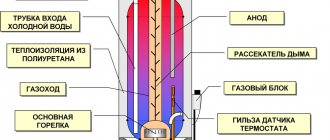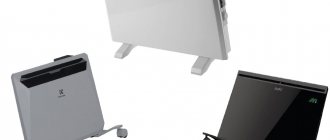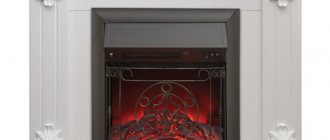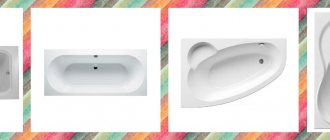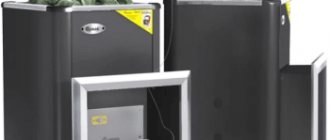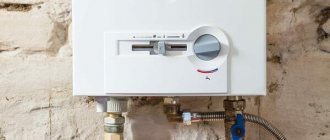Today, bimetallic radiators are recognized as the best for water heating systems, which combine aluminum And steel, accordingly, have the advantages of two metals. In terms of power, they are not inferior to aluminum or steel radiators, and in terms of wear resistance - to cast iron ones. We bring to your attention a rating of the best bimetallic radiators for a private home, apartment and office.
| Model | Price per section |
| 1.ATM THERMO 500 | from 520 rub. |
| 2. Fondital Alustal 500/100 | from 450 rub. |
| 3. Global STYLE PLUS 500 | from 1200 rub. |
| 4.ROMMER Profi BM 500 | from 480 rub. |
| 5. ROYAL THERMO VITTORIA 500 | from 1240 rub. |
Mini rating
Bimetallic radiator - general information
The most practical choice for rooms of different sizes and purposes is bimetallic radiators. The devices are constructed of steel and aluminum. The radiator has high heat transfer, while being resistant to corrosion processes, reliable and practical.
Bimetallic radiator has the advantages of two metals
The following types of bimetallic radiators are distinguished:
full bimetallic - produced using the casting method, the advantage of the design is that the likelihood of metal contact with the coolant is eliminated, withstands heating up to +130 degrees , pressure up to 35 bar ;
part-bimetallic - in the design of a steel exclusively water-conducting channel, the issue of excess pressure is thus resolved, but the threat of the spread of corrosion remains.
Advantages:
- strength;
- versatility;
- high heat transfer;
- simple installation;
- exact parameters;
- the design is not hazardous;
- it is possible to install the valves necessary to control the temperature;
- long period of operation.
Pay attention to the material the tubes are made of - they must be steel
What you need to know about the types of bimetallic batteries
At first glance, bimetallic radiators seem the same, but these designs are classified according to different criteria.
Bimetallic and semi-bimetallic
In bimetallic structures, the outer casing is made of aluminum, and stainless steel and copper are used for the convector core.
In accordance with the technology, a sealed product of high strength is obtained, with maximum protection against leaks. In semi-bimetallic models, the internal frame is made of several metals - stainless steel, aluminum. This design is less durable than a bimetallic one; corrosion processes and leaks are likely.
Artyom Ivanov
Plumber, author of the channel “Good-natured Plumber”
Externally, bimetallic and semi-bimetallic radiators are practically the same. To understand which radiator is in front of you, pay attention to its lower part. For a semi-bimetallic one, there will be specific oval plugs located there. But a completely bimetallic one does not have this.
Sectional radiators
Each section is attached using nipples, thus forming a radiator of the required power.
Pipe sections located horizontally have multi-directional threads. Stacked designs are practical; they allow you to adjust the power by adding or subtracting sections. Such designs also have disadvantages First of all, these are joints; the permissible operating pressure readings are limited.
A significant drawback of stacked radiators is that coolant gets on the aluminum in the event of a leak, resulting in corrosion, and the structure requires replacement faster.
Monolithic radiators
Solid, cast batteries do not have the disadvantages of stacked structures; they are designed for pressures of up to 100 atmospheres , but there is no ability to regulate the power and the price of such structures is on average 30% higher . The main area of use is high-rise buildings where there is high pressure in the heating system.
Which radiators are better
1. Cast iron radiators.
Modern cast iron batteries look much more attractive, more compact and elegant in comparison with outdated, Soviet models.
Advantages - durability, resistance to corrosion processes.
Disadvantages : heavy weight, slow heating.
Important! The main cause of failure is clogging with sediment. It is recommended to soften the water or use antifreeze.
2. Aluminum radiators.
They have high heat transfer, are lightweight, quite attractive, and are easy and quick to install. There are assembled structures of 10 sections , or select the required number of sections yourself.
Advantages : aluminum heats up and cools down quickly, affordable price, compatibility with different heating systems.
If we talk about the disadvantages - it cannot be used in systems where it is difficult to control the coolant; aluminum is not compatible with noble metals.
Important! Plastic pipes are used with aluminum batteries, and grounding is also organized.
3. Steel, panel radiators.
This option is most popular for installation in cottages, but steel batteries are not suitable for multi-storey buildings due to the low operating pressure.
Steel radiators have a fairly long service life, are easy to install, have different mounting options, and offer a wide range of radiator sizes.
The main disadvantage is susceptibility to corrosive processes.
4. Bimetallic radiators.
An optimized, improved analogue of aluminum batteries with one difference - a steel distribution tube is installed inside. The design can withstand pressures of more than 35 atmospheres .
Bimetal does not have many disadvantages
Artyom Ivanov
Plumber, author of the channel “Good-natured Plumber”
Before buying a radiator, be sure to find out the level of acid-base balance of the coolant in the house. If the pH is between 7 and 8.5, then an aluminum radiator must be installed in the system. And if the pH is in the range from 7 to 9.5, then choose bimetallic. Only after this can you begin to select a manufacturer.
Sectional or monolithic bimetal?
More common on the market is the sectional version of bimetallic heating radiators. This is justified by the fact that it provides greater scope for installation in various conditions. It allows you to easily add or subtract the required number of sections when calculating the heating area and has an affordable price.
USEFUL INFORMATION: How to bleed air from a heating radiator: use the Mayevsky tap
The monolithic design has improved performance characteristics: it can withstand significantly higher coolant pressure, easily withstand even the most powerful water hammer and have a service life of 100 years. Leaks between blocks that are possible with sectional radiators are also eliminated. The described qualities are achieved due to a solid steel core, which has no weak points in the form of docking nipples.
The main disadvantage of monolithic bimetal is its high cost.
The best companies of bimetallic radiators
Royal Thermo . A domestic brand that produces products that meet European standards using equipment from Switzerland , Italy , and Spain . The quality of each stage of production is strictly controlled.
ATM . Another domestic brand that produces high-quality and at the same time inexpensive heating radiators for apartments. Domestic raw materials are used, coloring is carried out using the complete immersion method. Users note the attractive, laconic design.
Global . An Italian manufacturer that offers on the domestic market radiators that are fully adapted to the local climate and operating conditions. Aluminum alloys used in aircraft construction and the automotive industry are used. Operation period 25 years .
Sira . The achievements of the Italian brand in the field of bimetallic heating devices are confirmed by patents. The brand's products are rightfully considered the standard of quality and reliability.
Rifar . The Russian brand specializes in the production of bimetallic radiators adapted to the Russian climate. The workshops are equipped with modern equipment.
Fondital radiators also received good reviews .
Sira
The Italian brand positions its products as premium products. It has stood out in the market due to its high quality and attractive design based on smooth, rounded shapes. In addition, the line includes models with quite rare center distances of 200 and 800 mm. The maximum coolant temperature is –110 °C, pressure – 30 atm.
The model range includes the following modifications:
- Sira Gladiator 200/350/500 (center distance) – 92/140/185 W (section power).
- Sira RS Bimetal 350/500/800 – 145/201/282 W.
- Sira Ali Metal 500 – 187 W.
USEFUL INFORMATION: How to select and apply paint to radiators
Connection methods
Side method . The pipe through which hot water is supplied is attached to the upper pipe, the return pipe to the lower one. The pipe is located on one side of the radiator. This connection method is only effective for a battery consisting of 15 sections .
Diagonal method . The coolant pipe is mounted on top on one side of the radiator, the return pipe is mounted on the bottom on the opposite side. The coolant is evenly distributed throughout the battery, ensuring high efficiency.
The bottom connection is used when pipes need to be hidden so that they do not spoil the interior. In this case, efficiency is reduced by 20% .
Which bimetallic radiators are best to buy?
The optimal choice is batteries that are resistant to the chemical composition of the coolant - acidity levels in the range from 6.5 pH to 9 pH .
For ease of installation, it is better to choose a radiator with a mass of one section of no more than 2 kg . In order for the structure to efficiently heat the room, it will require a heat output of about 150 W and the ability to withstand pressure of at least 25 bar .
Only a competent choice of radiator guarantees comfort in the room and rapid heating of the air.
How many sections will be needed?
To determine the required number of sections for a specific area, you should first look at the technical data sheet of the radiator. This document contains information about the thermal power of each section, expressed in watts, which will be needed to calculate their number. The required volume of heat generated by radiators depends on the characteristics of the heated area. Let's look at common options.
USEFUL INFORMATION: How to replace heating radiators in an apartment with your own hands
| Room parameters | Required power for heating 1 sq. m area |
| One window, one wall facing the street, ceiling height – 250–270 cm | 100 W |
| One window, two external walls, similar height | 120 W |
| Two walls to the street and two windows | 130 W |
How is the calculation made?
Calculating the required number of sections is simple.
- To obtain the required thermal power of radiators for a room, we multiply the area by the heating power indicator determined from the table above. If the apartment has unusually high ceilings or panoramic windows, then a correction is applied and the result is additionally multiplied by 1.1.
- The power value for a separate section is taken from the bimetallic radiator passport. Then the result obtained in step 1 is divided by the figure taken from the instructions for the device. This way you get the required number of sections for the room. Non-integer values are rounded up. The same is done with the number of sections, since often the radiator consists of an even number of them.
Calculation example
To speed up the operation of counting sections, use the following formula:
Ks = P × Mk / Ms
- Ks – number of sections;
- P – area of the heated room;
- Mk – power required to heat 1 sq. m;
- Ms – thermal power of one section.
For high ceilings or large windows, the resulting Kc value is multiplied by a correction factor of 1.1.
For example, you need to install a bimetallic radiator in a room of 20 square meters of standard height with two walls facing the street and one panoramic window. Using the formula, we calculate: 20 sq. m multiplied by the required heating power of 120 W and multiplied by 1.1. We divide the result by the power of one section, for example, 200 W.
20 × 120 × 1.1 = 2640 W – total radiator power.
2640 / 200 = 13.2 – number of sections.
Due to the fact that more often the number of sections is even, we round up and get a battery with a length of 14 sections. Other calculation formulas can be found here.
For your information. Some suppliers agree to mount or remove the required number of sections from the radiator at the request of the customer.




